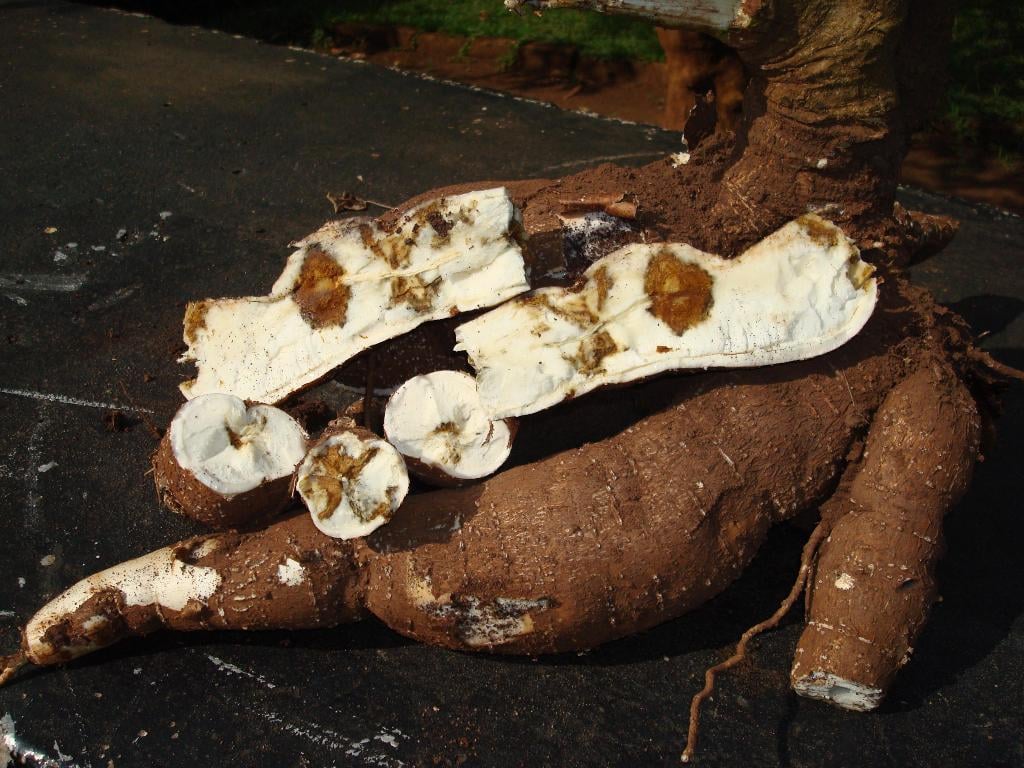Farmers in the central district of Mukono have been hardest-hit by the Cassava Brown Streak Disease (CBSD), a devastating viral infection that affects the edible parts – the tuberous roots and sometimes leaves - leading to a total loss of yields in most cases. It is spread by white flies.
Mike Thresh, a consultant on cassava viral diseases, said the disease was now occurring in areas previously believed to be immune, such as high altitude areas away from the Indian Ocean coastal belt of Kenya, Tanzania and Mozambique.
"[Initially] there was a sort of dogma that built up in scientists that there is an altitude ceiling and that it [the disease] was not a problem once one exceeded 1,000m above sea level," Thresh said. "The gravity of the situation is that almost all varieties bred or selected for resistance to Cassava Mosaic Disease [CMD] are susceptible to the 'new strain' of CBSD occurring in Uganda, inland areas of Tanzania and Western Kenya.
"Unlike [the] case of mosaic disease where the plant is affected as well as the yields, in the case of CBSD, the plant remains extremely vigorous and you pass by it and conclude that it is okay, but the problem comes when you look at the roots. What is more worrying is that it takes about 10 years to develop a variety," Thresh said.
The symptoms include root constriction and a dry hard rot when the root is cut. It also causes cracks and discolouration in the tubers while the harvested roots have corky, yellow-brown spots. It also causes patches of yellow mixed with normal green on the leaves, a phenomenon commonly referred to as chlorosis.
Shattered dreams
Sarah Nassiwa, 50, a cassava farmer in Mukono district, has for many years relied on cassava as a staple and cash crop but her dreams of becoming a commercial farmer have been dashed by CBSD.
Nassiwa had 2ha under cassava but most of the tubers have rotted after they were hit by the disease. She is at a loss as to how she will continue feeding and educating her children.
"We love our cassava because we have relied on it for consumption and for household income, but all that is gone," Nassiwa said at her farm in Businje in Goma sub-county. "What disappoints most is that you boast that you have a big garden but it surprises when the whole crop is rotten."
|
Photo: Vincent Mayanja/IRIN  |
| An official displays tubers infected by the Cassava Brown Streak Disease in Mukono district, central Uganda |
The disease can render susceptible varieties unusable if cassava roots are left in the ground for more than nine months.
Stephen Mukasa, the district agricultural officer for Mukono, told IRIN that almost all the cassava crop in the area, where 85 percent of residents are farmers, had been affected by the disease, threatening the population's food security.
"We have tried to sensitize farmers about the disease and how to halt its spread - like destroying affected plants - but it keeps on spreading. Materials that we thought could be resistant have turned out to be susceptible to it. Even clean materials are very costly because it requires five bags costing 25,000 shillings [US$12.50] each to plant 0.4ha and very few farmers can afford this."
Anton Bua, an agricultural economist and team leader of the cassava programme in the Ministry of Agriculture, said CMD in the early 1990s had reduced to zero Uganda’s cassava output of six million tonnes from some 202,342ha with a loss of $60 million per year.
“This had recovered to one billion tonnes of yield by 2005 but by 2009 the area under production had not decreased but the production and the quality had gone down [due to] a new strain of the brown streak disease,” Bua said.
“We are faced with a more serious situation than we witnessed with the mosaic disease," he added. "A recent tally indicates that over 70 percent of Ugandans feed on cassava, with the populations in the east and west Nile regions depending on cassava 100 percent."
vm/js/mw
This article was produced by IRIN News while it was part of the United Nations Office for the Coordination of Humanitarian Affairs. Please send queries on copyright or liability to the UN. For more information: https://shop.un.org/rights-permissions





